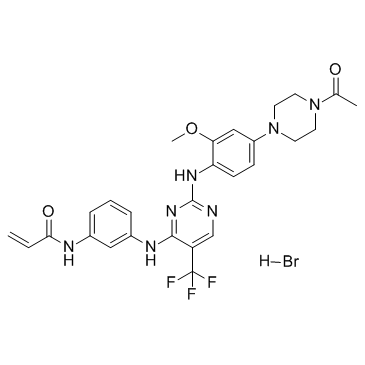CO-1686 hydrobromide
Modify Date: 2024-01-05 12:28:03

CO-1686 hydrobromide structure
|
Common Name | CO-1686 hydrobromide | ||
|---|---|---|---|---|
| CAS Number | 1446700-26-0 | Molecular Weight | 636.464 | |
| Density | N/A | Boiling Point | N/A | |
| Molecular Formula | C27H29BrF3N7O3 | Melting Point | N/A | |
| MSDS | N/A | Flash Point | N/A | |
Use of CO-1686 hydrobromideCO-1686 hydrobromide is an orally delivered kinase inhibitor that specifically targets the mutant forms of EGFR including T790M, and the Ki values for EGFRL858R/T790M and EGFRWT are 21.5 nM and 303.3 nM, respectively. |
| Name | N-(3-{[2-{[4-(4-Acetyl-1-piperazinyl)-2-methoxyphenyl]amino}-5-(trifluoromethyl)-4-pyrimidinyl]amino}phenyl)acrylamide hydrobromide (1:1) |
|---|---|
| Synonym | More Synonyms |
| Description | CO-1686 hydrobromide is an orally delivered kinase inhibitor that specifically targets the mutant forms of EGFR including T790M, and the Ki values for EGFRL858R/T790M and EGFRWT are 21.5 nM and 303.3 nM, respectively. |
|---|---|
| Related Catalog | |
| Target |
EGFRL858R/T790M:21.5 nM (Ki) EGFRT790M:303.3 nM (Ki) |
| In Vitro | CO-1686 (0.1 μM) inhibits EGFR potently and irreversibly, and inhibits more than 50% of 23 targets. CO-1686 potently and selectively inhibits growth of NSCLC cells expressing mutant EGFR and induces apoptosis. CO-1686 resistant NSCLC cell lines are sensitive to AKT inhibition[1]. |
| In Vivo | CO-1686 (100 mg/kg/day, p.o.) demonstrates anti-tumor activity in NSCLC EGFR mutant xenograft models. CO-1686 (50 mg/kg bid, p.o.) demonstrates anti-tumor activity in human EGFR-L858R and EGFR-L858R-T790M expressing transgenic mice[1]. |
| Cell Assay | Cells are seeded at 3,000 cells/well in growth media supplemented with 5% FBS, 2 mM L-glutamine, and 1 % P/S, allowed to adhere overnight, and treated with a dilution series of test compound (CO-1686) for 72 hr. Cell viability is determined by CellTiter Glo and results are represented as background-subtracted relative light units normalized to a DMSO-treated control. Growth inhibition (GI50) values are determined by GraphPad Prism 5.04. Combination index (CI) data is generated using CalcuSyn. |
| Animal Admin | Briefly, NCr nu/nu mice are sub-cutaneously implanted with 1×107 tumor cells in 50% Matrigel (injection volume of 0.2 mL/mouse). Once tumors reached 100-200 mm3, Animals are dosed with compounds (CO-1686) as outlined (N=10 animals/gp). The LUM1686 PDX xenograft study is performed by CrownBio. Briefly, LUM1686 PDX tumor fragments, harvested from donor mice, are inoculated into BALB/c nude mice. Administration of test compounds (CO-1686) is initiated at a mean tumor size of approximately 160 mm3. Tumor growth is monitored over time to determine tumor growth inhibition of the experimental agent vs. vehicle. The endpoint of the experiment is a mean tumor volume (MTV) in control group of 2000 mm3. Percent TGI is defined as the difference between the MTV of the designated control group and the MTV of the drug-treated group, expressed as a percentage of the MTV of the designated control group. Data is presented as mean±standard error of the mean (SEM). |
| References |
| Molecular Formula | C27H29BrF3N7O3 |
|---|---|
| Molecular Weight | 636.464 |
| Exact Mass | 635.146729 |
| 2-Propenamide, N-[3-[[2-[[4-(4-acetyl-1-piperazinyl)-2-methoxyphenyl]amino]-5-(trifluoromethyl)-4-pyrimidinyl]amino]phenyl]-, hydrobromide (1:1) |
| N-(3-{[2-{[4-(4-Acetyl-1-piperazinyl)-2-methoxyphenyl]amino}-5-(trifluoromethyl)-4-pyrimidinyl]amino}phenyl)acrylamide hydrobromide (1:1) |
| CO-1686 (hydrobroMide) |
| CO-1686 hydrobromide |